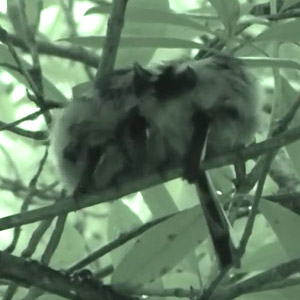Pratique | Débuter
Quand les oiseaux se blottissent les uns contre les autres pour se tenir chaud

Mésanges à longue queue (Aegithalos caudatus) blotties les unes contre les autres en dortoir en février 2011.Source : image extraite d’une vidéo postée par Jwentomologist sur Youtube
Introduction
De nombreuses espèces d’oiseaux migrent vers des latitudes plus clémentes en automne, mais d’autres restent sur place et elles doivent alors affronter des températures basses, surtout lors des longues nuits hivernales.
Les plumes constituent un bon isolant, mais les pertes de chaleur ne disparaissent jamais totalement. Lorsqu’ils n’ont rien à manger ou qu’il fait très froid, les oiseaux peuvent économiser de l’énergie en réduisant leurs besoins en régulation thermique en réduisant la température de leur corps de manière contrôlée, en entretenant leur plumage, en trouvant un abri dans une cavité ou sous la neige et/ou en se blottissant les uns contre les autres.
Ce dernier comportement, appelé aussi « thermorégulation sociale », est une stratégie d’économie d’énergie largement utilisée par les oiseaux (poussins, juvéniles et adultes) et les petits mammifères confrontés à de fortes dépenses énergétiques.
Dans cet article, nous présentons les avantages et inconvénients de se « coller » les uns contre les autres, les espèces d’oiseaux concernées et les règles qui déterminent les positions des individus.
Abstract
Many bird species migrate to warmer latitudes in autumn, but the others are sedentary and then they must face low temperatures, especially during the long winter nights .The feathers are a good insulator, but heat loss never completely disappears. When they have nothing to eat or when it is very cold, the birds can save energy by reducing their body temperature in a controlled manner, by cleaning their plumage, by finding a shelter in a cavity or under snow and/or by huddling.
Huddling, also called « social thermoregulation », is a powerful energy saving strategy widely used by mammals and birds facing high energetic demands by avoiding heat loss. It is often observed in birds and rodents, which, because of their small body size, are prone to relatively high heat loss.
In this article, we present the advantages and disadvantages to huddle together, the species involved and the rules that determine the positions of individuals.
Poursuivez la lecture de cet article, en vous abonnant dès maintenant !
Découvrez les Archives d’Ornithomedia.com
Pour seulement 10,00 €TTC/an (ou 6,00 € les 6 mois)
Profitez de plusieurs centaines d’articles en accès illimité et sans aucun engagement.
Compléments
À lire aussi sur Ornithomedia.com
- Les adaptations des oiseaux pour supporter le froid
- Chez les oiseaux aussi, qui dort dîne
- Comment les oiseaux supportent-ils les nuits d’hiver et comment les aider ?
- Une véritable grappe de martinets !
Ouvrages recommandés
- Recueillir et soigner les petits animaux sauvages (Relié) de Gérard Grolleau
- Guide des oiseaux de nos jardins de Claude Feigné (Auteur) et Gérard Schmitt (Auteur)
- Le Traité Rustica des oiseaux du jardin de Guilhem Lesaffre (Auteur), Catherine Levesque (Auteur) et Emmanuel Risi (Auteur)
- Le guide des oiseaux autour de chez vous : Observer, Reconnaître, Nourrir, Protéger (Broché) de Gilles Leblais, Jean Chevallier (Illustrations), Allain Bougrain Dubourg (Préface)
Sources
- Burns, D. J., Ben-Hamo, M., Bauchinger, U. et Pinshow, B. (2013), Huddling house sparrows remain euthermic at night, and conserve body mass. Journal of Avian Biology, (44). Pages : 198–202.. http://onlinelibrary.wiley.com
- Martin U. Grüebler, Silv Widmer,Fränzi Korner-Nievergelt,Beat Naef-Daenzer (2013). Temperature characteristics of winter roost-sites for birds and mammals: tree cavities and anthropogenic alternatives. International Journal of Biometeorology. http://link.springer.com/article/10.1007/s00484-013-0643-1
- Michał S. Wojciechowski,Małgorzata Jefimow et Berry Pinshow (2011). Heterothermy, and the Energetic Consequences of Huddling in Small Migrating Passerine Birds. Integrative and Comparative Biology. Volume 51, numéro 3. Pages : 409-418. http://icb.oxfordjournals.org/content/51/3/409.short
- RA Noske(1985). Huddle-roosting behaviour of the Varied Sittella Daphoenositta chrysoptera in relation to social status. Emu (85). Pages 188-194. http://www.publish.csiro.au/paper/MU9850188
- Clare J. Napper,Stuart P. Sharp,Andrew McGowan Michelle Simeoni,Ben J. Hatchwell(2013). Dominance, not kinship, determines individual position within the communal roosts of a cooperatively breeding bird. Behavioral Ecology and Sociobiology. Volume 67, numéro 12. Pages : 2029-2039. http://link.springer.com/article/10.1007/s00265-013-1613-7#page-1
- Zitterbart DP, Wienecke B, Butler JP, Fabry B (2011) Coordinated Movements Prevent Jamming in an Emperor Penguin Huddle. PLoS ONE 6(6): e20260. http://www.plosone.org/article/info%3Adoi%2F10.1371%2Fjournal.pone.0020260
- Beirnd Heinrich (2003). Overnighting of Golden-crowned Kinglets during winter. The Wilson Bulletin 115(2). Pages : 113-114. http://www.bioone.org/doi/abs/10.1676/03-035?journalCode=wils.1
- Calf, K., Adams, N. and Slotow, R. (2002), Dominance and huddling behaviour in Bronze Mannikin Lonchura cucullata flocks. Ibis, 144. Pages : 488–493. http://onlinelibrary.wiley.com
- W. J. Peach , T. S. H. Gibson & J. A. Fowler (1987) Huddling behaviour in
roosting Starlings Sturnus vulgaris. Bird Study, 34:1. Pages : 37-38. www.tandfonline.com/doi/pdf/10.1080/00063658709476933 - Scott Ruey-Shing Lin, Lien-Siang Chou et Yao-Sung Lin (2003). Roosting Behavior of the Grey-Cheeked Fulvetta Alcippe morrisonia Swinhoe in the Non-breeding Season. Ntur. http://ntur.lib.ntu.edu.tw/retrieve/168267/02.pdf




Aucun commentaire sur ce sujet
Participer à la discussion !